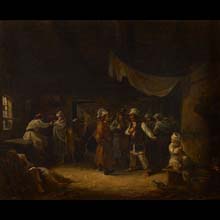
material: oil on canvas
dimensions: 54 × 66 cm
description: Franciszek Kostrzewski was a painter and draughtsman associated with the Warsaw art milieu. The composition entitled Peasants in an Inn is the result of his sightseeing and ethnographic tours. This genre scene, inspired by the works of the so-called 17th-century Dutch Little Masters, is set at a provincial inn. The dim interior, furnished with simple furniture, is illuminated with sunlight coming in through a small window. Shabbily dressed, barefoot and dirty peasants with stocky figures and almost grotesque physiognomies are off-putting, both in their looks and hearty behaviour. A narrow range of colours oscillates between browns, black, grey and off-white. Kostrzewski tried to portray the life of peasants without idealization. The poverty, backwardness and moral decay of the Polish countryside, caused by centuries-old negligence, became the subjects of a particularly large number of works in the age of positivism. Elements of ugliness and deformation, visible in the picture, are aimed at highlighting the problem. In accordance with the principle of preserving “types” and “characters,” the artist did not portray a real situation, but only model figures representing – a bit tendentiously – a given social and psychological pattern. Aleksandra Krypczyk
exposition: The Gallery of 19th Century Polish Art in Sukiennice,
The Cloth Hall, 1, Main Market Square
key: Realism, polish impressionism, beginnings of symbolism >>>
dimensions: 54 × 66 cm
description: Franciszek Kostrzewski was a painter and draughtsman associated with the Warsaw art milieu. The composition entitled Peasants in an Inn is the result of his sightseeing and ethnographic tours. This genre scene, inspired by the works of the so-called 17th-century Dutch Little Masters, is set at a provincial inn. The dim interior, furnished with simple furniture, is illuminated with sunlight coming in through a small window. Shabbily dressed, barefoot and dirty peasants with stocky figures and almost grotesque physiognomies are off-putting, both in their looks and hearty behaviour. A narrow range of colours oscillates between browns, black, grey and off-white. Kostrzewski tried to portray the life of peasants without idealization. The poverty, backwardness and moral decay of the Polish countryside, caused by centuries-old negligence, became the subjects of a particularly large number of works in the age of positivism. Elements of ugliness and deformation, visible in the picture, are aimed at highlighting the problem. In accordance with the principle of preserving “types” and “characters,” the artist did not portray a real situation, but only model figures representing – a bit tendentiously – a given social and psychological pattern. Aleksandra Krypczyk
exposition: The Gallery of 19th Century Polish Art in Sukiennice,
The Cloth Hall, 1, Main Market Square
key: Realism, polish impressionism, beginnings of symbolism >>>












